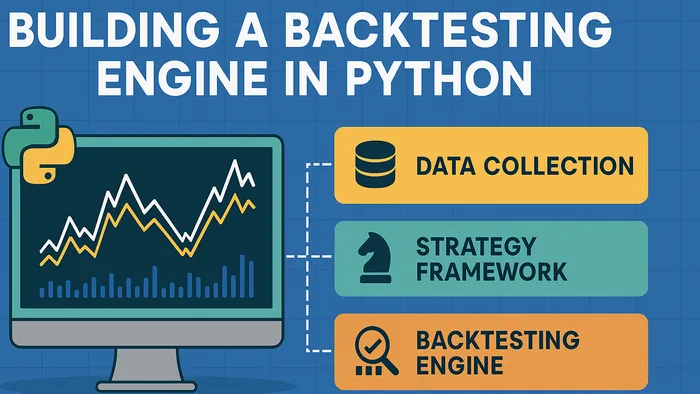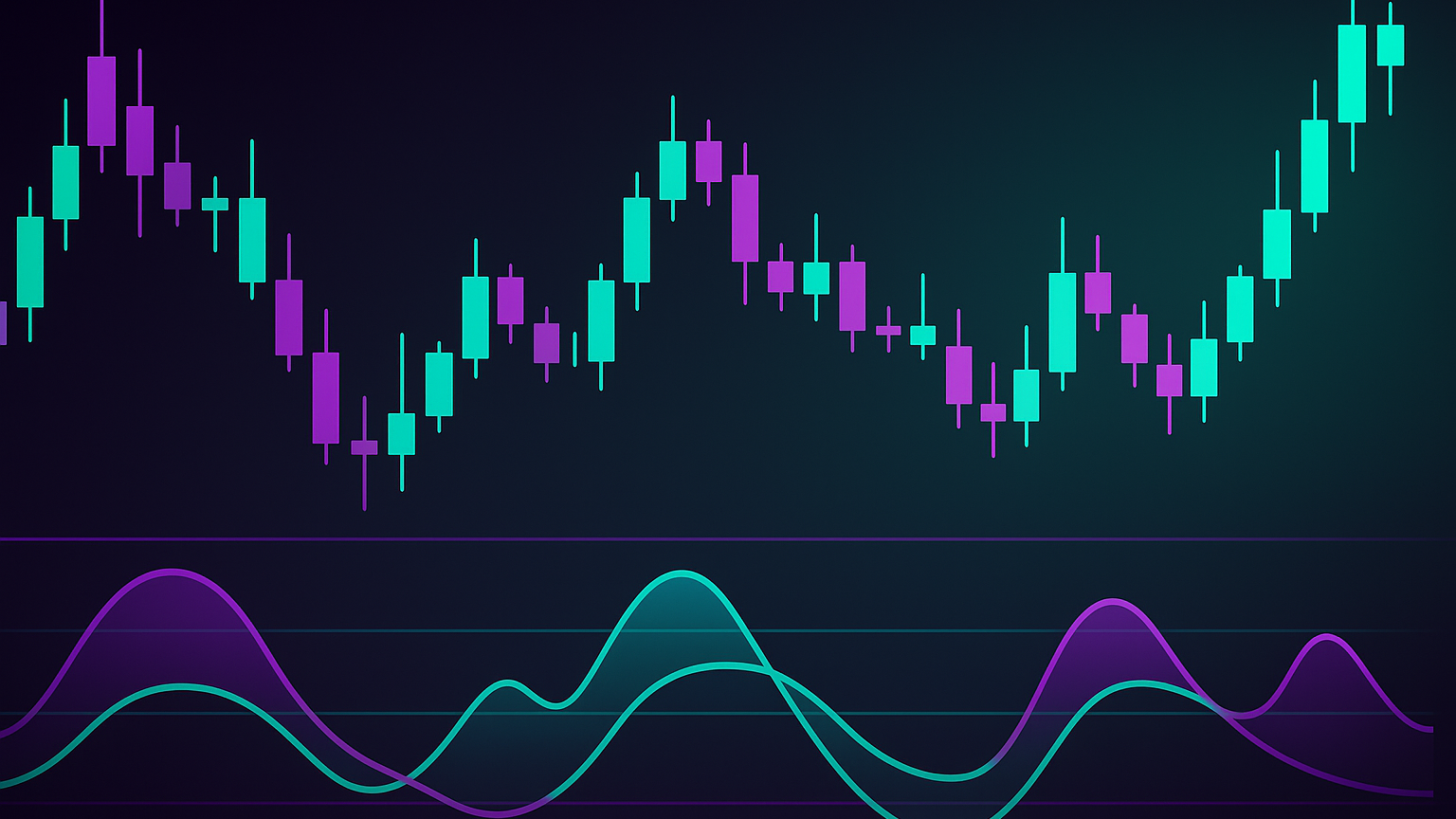Learn how to create a Python backtesting engine for trading strategies, including data handling, indicator calculations, and performance metrics.
For traders striving to refine their strategies and embrace a systematic, data-driven approach to financial markets, backtesting remains an indispensable practice. In this article we delve into how to build a Python-based backtesting engine, covering architecture, design considerations, and pitfalls. By the end of this guide, you’ll be equipped with a clear understanding of the core components required to recreate—or tailor—such an engine for optimising your trading strategies. If you’re using LuxAlgo, keep in mind that LuxAlgo’s AI Backtesting platform offers a fully-hosted alternative that can generate and evaluate strategies from natural-language prompts.
Why Backtesting Matters
Backtesting lets traders evaluate how a strategy would have fared in historical markets, helping bridge the gap between theoretical models and real-world performance. A robust engine enables you to simulate entry and exit points, quantify performance metrics, and refine strategy logic — all while reducing the impact of emotional or impulsive trading decisions.
Backtesting also has limits: past performance never guarantees future results, and unless the engine models market realities (transaction costs, latency, slippage, bid/ask spreads, liquidity) the results can be misleading. If you want a no-code pathway that bakes many best practices into repeatable workflows, the AI Backtesting Assistant introduction explains how LuxAlgo evaluates strategies and replicates them on TradingView. For a practical overview contrasting methodologies, see Backtesting vs. Forward Testing.
Core Components of the Backtesting Engine
The engine we’ll discuss is structured into three primary modules: data ingestion, strategy logic, and execution/backtesting simulation. A fourth cross-cutting module—performance evaluation and reporting—is equally important.
- Data Collection & Preparation Module: Handles ingestion, cleaning, alignment, and storage of historical market data. For a ready-made option on TradingView, explore LuxAlgo Backtesters.
- Strategy Framework Module: Encapsulates trading logic—signal generation, filters, timing, and position sizing. If you prefer configurable, chart-native tools, review LuxAlgo Algos.
- Backtesting/Execution Module: Simulates how the strategy would execute in the market: loops through data, applies signals, updates portfolio, logs trades. The Backtester (S&O) docs show how this looks on-platform.
- Performance & Reporting Module: Calculates output metrics (returns, drawdowns, risk ratios), visualises equity curves and trade logs, and helps you compare variants. For a product-wide overview, see LuxAlgo Features.
Below we break each of these down in more detail and show how they interconnect.
1. Data Loading and Preparation
The first step in any backtester involves loading historical market data—price bars (OHLCV) and, optionally, higher-frequency ticks or order-book snapshots. Key sub-steps include:
- Validating Data Format: Ensure essential fields (timestamps, open, high, low, close, volume) are present; verify no gaps, duplicates, or stock splits/dividends inconsistencies.
- Timezone & Timestamp Alignment: Convert timestamps to a unified timezone and standard datetime index (e.g., use
pandas.to_datetime()), especially important for multi-asset, multi-exchange tests. - Resampling / Clean-Up: For higher-frequency data you may need to drop or forward-fill missing bars, adjust for corporate actions, and align series if running multi-instrument strategies.
- Data Slicing / Lookback Window: Many strategies require “warm-up” periods (e.g., initial 200 bars) before signals begin—this avoids look-ahead bias.
Clean and well-structured data underpin any reliable backtest. If you want to bootstrap discovery rather than build a data pipeline from scratch, the Assistant’s Fetching Strategies guide shows how to automatically search millions of candidate strategies based on your criteria.
2. Calculating Indicators
Technical indicators (e.g., Relative Strength Index, moving averages, Bollinger Bands, MACD) are core to many strategies. In the engine:
- RSI is typically calculated over a rolling 14-period window on closing prices; you might use a library (e.g.,
ta,pandas_ta) or code your own RSI logic. - These calculations must be tied to each bar in the historical series so that, at each time step, the strategy sees only past data (no future look-ahead).
- Keep indicator logic modular so you can plug in new metrics (e.g., EMAs, Donchian Channels, volume-based features) with minimal changes.
Indicators are inputs; the strategy logic—triggers, filters, sizing, and execution assumptions—decides behaviour. To see how indicators power strategy generation within LuxAlgo, skim the AI Backtesting Assistant breakdown and platform-wide LuxAlgo Docs.
3. Iterative Strategy Execution
The core of a realistic backtesting engine is its iterative simulation loop—processing one time step at a time, generating signals, executing trades, updating portfolio state:
- Load validated historical data and perform a warm-up if needed.
- Initialize the equity curve (track starting capital, current cash, current holdings).
- Loop through each row (bar/tick) chronologically:
- Calculate indicators at this timestamp.
- Feed the data into the strategy’s
on_tick()(orgenerate_signals()) method—deciding whether to buy, sell, or hold. - If a signal triggers, pass to an execution engine: determine position size, simulate fills, deduct transaction costs, update portfolio holdings and cash.
- Record trade details, update positions, and mark-to-market portfolio value.
This event-loop architecture avoids “look-ahead bias,” enables realistic modelling of order timing and fills, and makes it easier to apply risk rules consistently. If you’d rather test ideas without coding an execution layer, try AI Backtesting, then review your assumptions with the Backtester (S&O) parameters.
For example, at each step you might run a command such as:
python main.py --strategy RSI --data data/bybit_1h.csv --capital 1000
This would simulate an RSI strategy on one-hour timeframes from Bybit with $1,000 starting capital.
4. Calculating Performance Metrics
After the simulation completes, the engine should compute meaningful performance and risk metrics, including:
- Win Rate: percentage of trades that ended profitably.
- Total Return / Annualised Return: capital growth, plus annualised figures for tests spanning >1 year.
- Maximum Drawdown: largest peak-to-trough decline.
- Average Gain / Loss: mean profit on winners and mean loss on losers.
- Sharpe / Sortino: risk-adjusted return measures based on return variance or downside deviation.
- Exposure & Turnover: time-in-market and trading frequency—higher turnover typically implies higher costs.
No backtest perfectly models live behaviour. Always consider slippage, fees, liquidity, and execution latency. If you’re working in-platform, the Backtesters and Algos pages outline practical controls and workflows for strategy evaluation. For a primer on market depth and fills, see a neutral overview of liquidity.
5. User Interface and CLI Integration
Once the engine is functional, wrapping it in a user-friendly CLI or GUI makes it more accessible. Key features include:
- Parameter input: starting capital, strategy type, symbols, timeframe, fees/slippage assumptions.
- Output: equity curve, trade log, performance summary, and charts (e.g., drawdown curve, rolling return, exposure).
- Batch-mode or portfolio testing: support running multiple strategies or instruments in one execution—important for portfolio construction.
Here’s a typical command-line invocation:
python main.py --strategy RSI --data data/bybit_1h.csv --capital 1000
This simulates the RSI strategy on one-hour timeframes from Bybit with $1,000 starting capital. Prefer a GUI-first approach on TradingView? Start with LuxAlgo Algos, then replicate or expand strategies using AI Backtesting. The product-wide Pricing page explains access levels.
Important Lessons and Insights
While the engine described is fully functional, it’s intentionally designed as a learning tool. Key points to keep in mind:
- Risk Management is non-negotiable: A backtest may show excellent returns but hide risks—e.g., extreme drawdowns, high leverage, or unrealistic fills. Build in sizing rules, stop-loss logic, max drawdown caps, and diversification. For platform context, skim Walk-Forward Testing vs Backtesting.
- Scalability and Flexibility: Modular design (data handler, signal generator, execution engine) lets you add new strategies, handle multiple instruments/timeframes, and adapt to live trading. To understand LuxAlgo’s breadth, browse the Docs hub and Features.
- Market Realism Matters: Model commissions, slippage, latency, bid/ask spread, partial fills, and order-type differences. Simple engines that fill at mid-price are okay for learning, but not for deployment. When you’re ready to unify triggers and filters from multiple toolkits into one strategy, read about LUCID.
- Avoiding Biases: Common pitfalls include look-ahead bias, survivorship bias, and over-fitting. Use out-of-sample tests and walk-forward methods. The Backtesting vs. Forward Testing article covers practical guardrails.
- Portfolio Perspective: Move beyond single-symbol tests to multi-asset, multi-strategy portfolios with correlation and drawdown control. Screening tools can help find complementary setups; see LuxAlgo Screeners.
Key Takeaways
- Backtesting Basics: A structured engine allows you to test strategies on historical data and simulate real-world conditions. If you prefer a managed alternative, use AI Backtesting.
- Core Components: Your engine must handle data ingestion/cleaning, strategy logic, iterative simulation, and performance calculation. For TradingView-native diagnostics, review Backtester (S&O).
- Indicator & Signal Logic: Indicators are building blocks; triggers, filters, and execution determine behaviour. Explore how LuxAlgo packages these in Algos.
- Iterative Simulation Over Bulk Processing: Row-by-row processing is more realistic than fully vectorised, precomputed signals. To accelerate discovery without building a loop, leverage Fetching Strategies.
- Comprehensive Performance Metrics: Evaluate beyond win rate—drawdown, Sharpe/Sortino, turnover, exposure. For platform context, see the Backtesters page.
- Build for Growth: Decide whether you’re prototyping or aiming for production. For a product overview and access levels, see Pricing and LuxAlgo Home.
- Trade Realities Beat Theory: Clean backtests can still diverge from live results without realistic assumptions. Read the high-level What is LuxAlgo? page to understand the product ecosystem you can plug into.
Conclusion
Building a backtesting engine in Python empowers traders to validate and optimise their strategies using solid, data-driven frameworks. The example engine outlined here offers a strong foundational architecture—but real edge comes from refinement. Integrate rigorous risk controls, realistic execution modelling, and a portfolio mindset to move from prototype to practical utility.
With persistence and thoughtful iteration, you can create a system that not only tests strategies but meaningfully transforms the way you trade. Whether you build your own from scratch or adopt a high-quality platform, ensure it reflects the complexity of real markets—not just the elegance of your strategy logic. Happy coding—and even happier trading!
Source: “Watch Me Build a Backtesting Engine Step by Step!” — Coder Trader, YouTube, Aug 20, 2025 — https://www.youtube.com/watch?v=Gz6HClyDmU8
Use: Embedded for reference. Brief quotes used for commentary/review.
References
LuxAlgo Resources
- AI Backtesting Assistant
- AI Backtesting: Introduction (Docs)
- AI Backtesting: Fetching Strategies (Docs)
- Backtester (S&O): Introduction (Docs)
- LuxAlgo Backtesters (Features)
- LuxAlgo Algos for TradingView (Features)
- LuxAlgo Features Overview
- Backtesting vs. Forward Testing (Blog)
- Walk-Forward Testing vs Backtesting (Blog)
- Introducing LuxAlgo’s AI Backtesting Assistant (Blog)
- LuxAlgo Blog
- LuxAlgo Docs Hub
- Pricing & Plans
- LuxAlgo Homepage
- What is LuxAlgo? (Docs)








